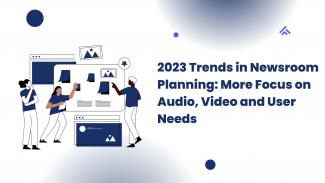Newsroom Shifts in 2023: Prioritizing Formats and User Needs

The Reuters Institute for the Study of Journalism's recent report ‘Journalism, media, and technology trends and predictions 2023’ revealed that audio and video formats are gaining popularity in 2023 with newsrooms and there is growing interest in short-form video production and user needs models in newsroom planning. This shift is leading to more cost-effective models, such as distributed newsrooms and newsletters, and a focus on delivering relevant stories to the right audience at the right time.
The future of the newsroom looks to be centered around format innovation and putting the interests of the reader at the forefront. This shift to multiple media formats requires accelerated content production. More content, across multiple media formats, means that newsroom planning needs to be in place to ensure that the right content reaches the right readers at the right time. We’re seeing a rise in editorial management tools to help newsrooms organize content across multiple formats and to get an overview of the entire newsroom workflow.
Format innovation: newsrooms are continuing to shift to audio and video
Format innovation has been a key driver of growth and change in the digital media landscape. With the advent of new technologies, faster data connections, and increasing smartphone adoption, newsrooms are exploring new ways to reach and engage with their audiences. The shift to audio and video formats is one of the most notable trends in this regard, as these formats offer new opportunities for storytelling and capturing the attention of readers.
The report discovered that 72% of publishers indicated that they will be focusing on podcasts and other digital audio formats in the coming year. This is an exciting development for the industry, as audio content offers unique benefits that set it apart from other formats. For one, audio content is well-suited to storytelling and in-depth analysis, which makes it an ideal format for covering complex topics in an engaging and accessible way. In-depth analysis and strong storytelling are two mechanisms that differentiate publications in the marketplace and keep readers loyal.
Another popular format among news publishers is newsletters, with 69% of respondents to the report indicating that they will be focusing on this channel in the coming year. Newsletters are a cost-effective way to reach audiences, as they can be delivered directly to subscribers' inboxes at no additional cost. In addition, newsletters offer a highly targeted way to deliver content, as publishers can segment their subscribers based on their interests and preferences, ensuring that their messages are highly relevant and engaging.
Digital video is also a high priority for publishers, with 67% of respondents to the report indicating that they will be focusing on this format in the coming year. The rise of digital video is due in large part to the growing popularity of visual storytelling and the increasing use of smartphones as a primary device for consuming content. With digital video, publishers can tell rich, visual stories that are immersive and engaging, which makes it an ideal format for capturing the attention of audiences. Furthermore, digital video is well-suited to social media distribution, which makes it an ideal format for reaching a large and highly engaged audience.
In addition to audio and video formats, there has also been a growing interest in short-form video production, which has seen a 4% increase in interest from publishers, according to the report. This growth is partly in response to changing social media strategies, as platforms like TikTok and Instagram continue to dominate the attention of younger audiences. By leveraging the popularity of these platforms, news publishers can reach a large and highly engaged audience, and in turn, build their brand and increase their exposure.
Audience-centric newsroom planning is becoming more popular
By adopting user needs models and jobs-to-be-done methodologies, publishers can identify opportunities and create content that addresses the specific problems, interests, and needs of their audiences.
This type of thinking has resonated with publishers such as the New York Times and has led to the development of publications that are shaped by the user needs matrix. Other publishers such as Conde Nast, Vox, The Atlantic, and Globo in Brazil have also been experimenting with these user needs models, with content tagged in CMS systems to allow continuous measurement of performance, as detailed in this interesting article from WAN-IFRA. This year, we can expect to see more examples of user needs models driving newsroom planning.
The trend in newsroom planning is shifting from solely focusing on individual pieces to commission to a comprehensive strategy that delivers relevant stories to the right audience at the right time. This requires a structured plan that provides a comprehensive view of the story and its related tasks.
Editorial management tools are on the rise
Our customers are using editorial management tools to create a content planning grid, which outlines the newsroom's content objectives for different times and audience needs. The planning grid includes all the tasks involved in creating a story, such as submitting copy and photos, allowing editors to track progress and identify gaps.
The grid helps keep track of completed and remaining stories and can also be used to set measurable goals. For instance, it can help editors adjust the publishing schedule to reach the target audience effectively and maximize the impact of the stories. With more meta-data being continuously added to newsrooms’ planning, we believe there will be a shift to a matrix planning structure, that encompasses all the meta-data collected for all audiences.
In conclusion, the shift towards audio and video formats continues to be a major trend in the digital media landscape. As publishers strive to connect with their audiences in new and meaningful ways, the use of new media formats, and placing user needs central is set to play a central role in their strategies in the coming year. However, this new way of working requires careful planning.
Our tool Kordiam is a newsroom planning tool designed for and used by newsrooms across the globe, so they can plan across multiple media formats and audiences with ease. Try Kordiam for free today.

